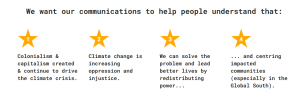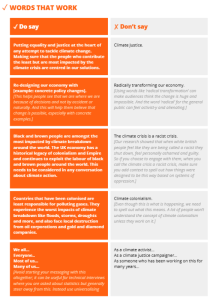*Also visit Climate Conscious Media and Media Literacy
1. Climate justice communication objectives
The Framing Climate Justice Project defines four communication objectives, ideas that the public needs to understand, namely that:

2. Recommendations for climate justice framing
The paper “How Australian Environmental Non-governmental Organisations Frame and Enact Climate Justice” examines how Australian ENGOs communicate and mobilise supporters around climate justice. Using data from ENGO websites and grant applications, the study reveals that while climate justice is framed as a procedural and distributive issue, most ENGOs focus on incremental actions like education and solidarity rather than radical, transformative change. Below are some recommendations.
- Co-design messaging, communication, campaigns
- Explain what Climate Justice is and how it relates to your Organisation specifically
- Understand and integrate Climate Justice Dimensions, especially relational, recognitional, intergenerational and procedural Climate Justice
- Explain and highlight transformative dimensions of Climate Justice that prioritise the opportunity to change structures and systems (influencing and transforming political, social and economic structures)
- Emphasise the importance of context and local relationships
- Outline locally important and effective actions for Climate Justice
- Highlight the importance of including marginalised voices and impacted communities in decision-making and support Indigenous people’s self-determination
- Conceptualise collective action and develop a collective action frame
- Clearly understand and define Climate Justice actions and pursued outcomes (include exact behaviours and what specifically entails in allyship, solidarity and increased input from affected communities)
- Prioritise transformative actions (such as disruptive civil resistance tactics outside of established political processes) over incremental/symbolic actions (such as educating others and increasing input from affected communities)
- Seek information and opportunities to collaborate with fossil fuel worker communities to deliver procedural and recognitional justice in Australia’s transition to clean energy and contribute to the removal of social licences from fossil fuel industries
3. The dos and don’ts of climate justice messaging
For Climate Justice campaigns to be successful, the language and framing of Climate Justice is crucial. Language is incredibly powerful; it shapes perceptions, influences behaviour, and drives change. The Framing Climate Justice project discovered that the frame of solidarity was the most effective and has developed resources to help people and organisations develop their message and communication.
The Climate Justice Messaging Guide, based on their research, lists the following tips:
- Start local; end global
- Build hope, not fear (be careful with emergency frames)
- Make sure affected groups have a voice and agency
- Talk about redesigning systems as the real solution
Health and design metaphors
Health Metaphor: Connecting human health to the planet’s health helps people understand the urgency of the climate crisis and support action. Words like “hurting” or “wounding” show the harm being done to the planet, while terms like “healing” or “curing” offer hope and a sense that solutions are possible.
Design Metaphor: The economy and society are products of design, and they can be redesigned for fairness and sustainability. Using words like “shaping” and “building” helps people feel empowered to change systems that seem unfair or unchangeable.
(Source: The Climate Justice Messaging Guide)
Core messages should include:
- Value: No matter our background or income, most of us want to leave future generations a healthy and beautiful planet. We also want to work together globally to find solutions.
- Problem: Our current economy is designed to benefit corporations and the wealthy, who profit from climate-damaging industries. For example, in the fashion industry, workers in countries like Bangladesh or Ethiopia are underpaid while big companies make huge profits.
- Impact: Climate change affects everyone, but it hits the poorest and communities of colour the hardest. From coastal erosion in Norfolk to oil spills in the Niger Delta, those who contribute least to the crisis are suffering the most.
- Solution: By coming together, we can create solutions that benefit everyone, especially those most affected. This could start with countries assessing how climate change disproportionately impacts certain groups and ensuring frontline communities lead the response. Solutions must come from collective efforts across all sectors and borders.


(Source: The Climate Justice Messaging Guide)
Read more:
Read more about the dos and don’ts of Climate Justice Messaging in the Climate Justice Messaging Guide.
See creative activities to help you develop your Climate Justice message in the Create Frames Worksheet.
Climate Outreach, a British charity that focuses exclusively on public engagement, provides several relevant resources. They include:
- Beyond ‘trusted messengers’ new insights on trust & influence in climate communications
- Supporting public engagement on climate change
- Care-full climate communication – a guide to communicating about care-centred, low-carbon societies
4. Inclusive storytelling and truth-telling
This section highlights the importance of inclusive storytelling and truth-telling in the context of climate justice and communication. By sharing diverse narratives that reflect the experiences, challenges, and resilience of various demographics—especially those disproportionately affected by climate change—communities can foster a deeper understanding of the intersectional nature of climate justice. Share diverse stories that represent various demographics and communities, particularly those disproportionately impacted by climate change. Highlighting their experiences, challenges, and resilience (Moser & Ekstrom, 2010).
The Climate Justice Needs an Intersectional Approach toolkit provides information on Intersectional Climate Justice and lists a glossary to better understand and apply inclusive language and storytelling when talking about Climate Justice.
Read more:
First Nations Organisations Fighting for Climate Justice, Climate Council
Why is truth-telling so important? Our research shows meaningful reconciliation cannot occur without it (The Conversation)
Read more
Climate Communications Resource Hub
Revolutionary Talk: Communicating Climate Justice (LeQuesne, T., 2016)
How Collective Action Communication Frames are Used to Drive Action on Climate Justice
Climate Communication Climate Communication is an American science and outreach project providing research-based information on climate change communication. It offers insights and strategies for effective climate communication.
Mastering the Art of Climate Communication: Effective Strategies and Techniques (Net Impact) This blog discusses the vital role of effective communication in addressing the urgent threat of climate change. It provides data-driven strategies and practical techniques for communicators to engage, inform, and mobilise diverse audiences across different sectors and demographics.
Demonstrating inclusive and respectful language RAP Drafting Resource (Reconciliation Australia)
Oxfam has created an Inclusive Language Guide that discusses specific commonly used terminologies and explains why some of them are inadequate, and offers just alternatives.
Telethon Kids Institute Inclusive Language Guide

